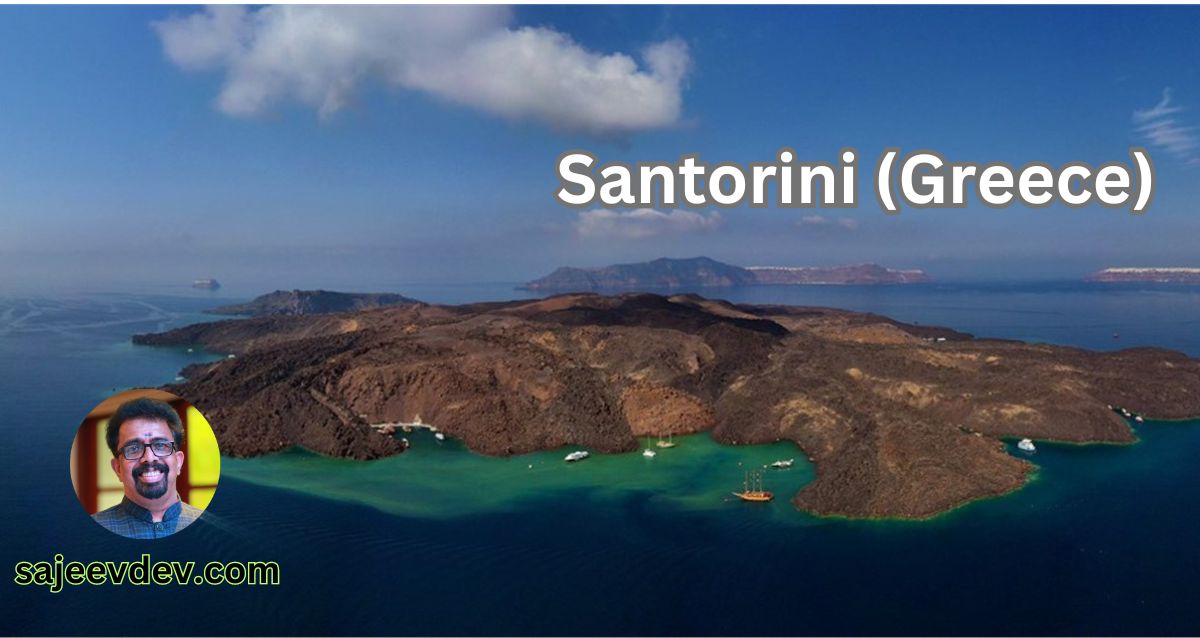Santorini
Situated in the heart of the Aegean Sea, Santorini is a striking volcanic island that forms part of the Cyclades archipelago. Known for its breathtaking sunsets, whitewashed houses, and stunning blue-domed churches, Santorini stands out as a prime destination for tourists from across the globe. The island’s unique geological characteristics stem from its volcanic origins, having been shaped by a series of significant eruptions over thousands of years, the most notable occurring around 1600 BCE. This immense volcanic activity not only molded the island’s dramatic landscapes but also played a critical role in its ancient history.
Historically, Santorini is believed to have been home to one of the most advanced civilizations of the Aegean, the Minoan civilization, which is evident in the ruins of Akrotiri. Often referred to as the “Minoan Pompeii,” this archaeological site showcases vibrant frescoes, complex architecture, and an advanced understanding of urban planning. The island’s rich history is interwoven with mythical narratives, such as the legend of Atlantis, which adds a layer of intrigue to Santorini’s cultural significance.
In modern times, Santorini has evolved into a premier tourist destination, attracting visitors with its luxurious resorts, exquisite dining, and exceptional wine offerings, particularly its renowned Assyrtiko wine. The sheer beauty of the caldera, with its steep cliffs and the azure waters of the Aegean, captures the imagination and hearts of those who visit. The island’s local crafts, vibrant arts scene, and culinary delights further enhance its appeal. Thus, Santorini is not simply a vacation spot; it is a hub of rich history, cultural experiences, and natural beauty, making it an essential part of any travel itinerary in Greece.
The Geography of Santorini
Santorini, one of the most renowned islands in the Aegean Sea, exhibits a striking and complex topography shaped significantly by its volcanic history. This remarkable island is known for its breathtaking caldera, which is a result of one of the largest volcanic eruptions in recorded history, dating back to approximately 1600 BC. The eruption led to the collapse of the central part of the island, subsequently creating the steep cliffs that loom over the deep blue waters of the caldera. These cliffs provide stunning panoramic views, especially at sunset, when the sky becomes a canvas of vibrant oranges, purples, and reds, attracting countless visitors each year.
The unique geography of Santorini is further defined by its crescent shape, which is a result of the caldera’s formation. This shape not only offers exceptional coastal views but also influences its local climate. The island enjoys a Mediterranean climate characterized by hot, dry summers and mild, wet winters. The optimal weather conditions contribute to the flourishing terraced vineyards and the cultivation of local products such as tomatoes, fava beans, and unique varietals of wine. The volcanic soil, rich in minerals, provides a fertile ground for these crops, adding to the island’s distinct culinary offerings.
The natural beauty of Santorini is not limited to its landforms and climate; it also extends to its stunning beaches, which vary in color due to the volcanic activity. Red Beach with its red cliffs, White Beach surrounded by white rock formations, and Black Beach composed of volcanic sand are just a few examples of the geographical diversity present on the island. These features, coupled with the splendid sunsets that the island is famous for, make Santorini a geographical marvel that captures the hearts of its visitors.
The Volcanic History of Santorini
Santorini, a picturesque island in the Aegean Sea, is renowned for its dramatic landscapes, stunning sunsets, and unique architecture. However, much of its charm stems from a volatile geological past shaped by significant volcanic activity. The most notable event in this history is the cataclysmic eruption that occurred around 1600 BC, which is believed to have led to the collapse of the thriving Minoan civilization on Crete, deeply influencing the region’s cultural development.
This eruption was part of a series of severe volcanic events that marked Santorini’s geological timeline. It is classified as one of the largest eruptions in recorded history, leading to the formation of the caldera that now delineates the island’s stunning cliffs. As the eruption expelled vast amounts of ash and pumice into the atmosphere, it resulted in climatic changes that affected not only Santorini but the surrounding Aegean territories as well. The ash fallout would have impacted agriculture and contributed to the decline of neighboring civilizations, making it a pivotal point in ancient history.
From a scientific perspective, the volcanic activity in Santorini is a product of the Hellenic Arc subduction zone. The oceanic crust of the African Plate is being thrust beneath the Eurasian Plate, creating conditions conducive to intense volcanic eruptions. The island itself is part of a stratovolcano system, characterized by layers of lava flows and explosive materials. This intricate geological setting has resulted in the creation of multiple volcanic islands within the caldera, called the Nea Kameni and Palea Kameni, which are constantly rebuilt by ongoing volcanic activity.
In summary, the volcanic history of Santorini is not just a narrative of destruction but also one of creation and transformation, leading to the island’s current allure and geological diversity. The island’s profile continues to evolve as natural processes shape its landscape, maintaining its status as a geological wonder and an enduring testament to the power of volcanic forces.
Impact of the 1600 BC Eruption
The eruption that occurred around 1600 BC on the island of Santorini is widely regarded as one of the most significant volcanic events in human history. This catastrophic eruption had far-reaching consequences for the Minoan civilization, which thrived in the Aegean region during that period. The violent explosion released massive amounts of ash and pumice into the atmosphere, leading to widespread devastation of the Minoan settlements not only on Santorini but also on nearby island communities and the mainland of Crete.
The extensive destruction resulted in the dislocation of entire populations, leaving behind ruins that would eventually become a subject of intense archaeological interest. Excavations in Akrotiri, an ancient Minoan town buried under volcanic ash, revealed remarkably well-preserved frescoes, pottery, and infrastructure. These findings shed light on the advanced technologies and artistic expressions of the Minoans, providing invaluable insights into their daily lives, trade networks, and societal structures. Archaeologists believe that the eruption not only caused immediate loss of life but also led to the decline of Minoan influence in the Aegean, creating a power vacuum that would later be filled by other civilizations, such as the Mycenaeans.
The historical implications of the Santorini eruption extend beyond the physical devastation. The event is often cited as a possible catalyst for the myths and legends of Atlantis, as accounts of a highly advanced civilization disappearing under the sea coincided with the timeline of the eruption. Furthermore, as researchers continue to analyze the remnants of this spectacular volcanic event, the archaeological significance is underscored by the ongoing discoveries that deepen our understanding of ancient cultures and their resilience in the face of natural disasters.
Last Eruption and Current Volcanic Status
Santorini, renowned for its striking beauty and stunning vistas, is also home to an active volcanic system that has played a significant role in shaping its landscape and history. The last eruption on the island occurred in 1950, when a series of explosive events took place at the volcanic island of Nea Kameni, situated within the caldera of Santorini. This eruption was relatively minor, with a Volcanic Explosivity Index (VEI) rating of 3, yet it served as a reminder of the island’s geological vitality. The formation of the current topography, including the iconic cliffs and caldera, is largely attributed to volcanic activity, with past eruptions having a profound impact on life in the region.
Today, volcanic activity in Santorini is closely monitored by various scientific organizations. The Geological and Meteorological Institutes of Greece regularly assess the caldera’s seismic activity, ground deformation, and gas emissions. These monitoring efforts are crucial in estimating potential volcanic hazards and determining the level of risk to the inhabitants and visitors of Santorini. This proactive stance has not only enhanced public safety but also shaped the local economy, as the tourism sector heavily depends on the island’s volcanic heritage.
The monitoring process has evolved significantly over the years, incorporating advanced technologies such as satellite imagery and ground-based observation systems. These capabilities allow experts to identify subtle changes in the volcano’s behavior, thus informing risk management strategies. As a result, both residents and visitors can enjoy the breathtaking landscapes of Santorini with a well-founded sense of security. In conclusion, understanding the historical eruptions and ongoing monitoring efforts provides valuable insights into life on Santorini, allowing its residents to thrive alongside the powerful natural forces that shape their environment.
Cultural Heritage and Ancient Settlement
Santorini, a treasure in the Aegean Sea, is renowned not only for its breathtaking landscapes but also for its rich cultural heritage shaped by its volcanic history. Ancient settlements such as Akrotiri offer a glimpse into the island’s past, showcasing the advanced civilization that thrived there before the catastrophic eruption in the 16th century BC. This archaeological site, often referred to as the “Pompeii of the Aegean,” reveals well-preserved structures and artifacts that highlight the architectural ingenuity and urban planning of the Minoans.
The ruins at Akrotiri feature multi-story buildings with sophisticated ventilation systems, intricate frescoes, and elaborate pottery. These findings point to a vibrant community engaged in trade, agriculture, and craftsmanship. The artwork unearthed within these walls exemplifies the island’s cultural connections across the Aegean and beyond, indicating its importance as a trading hub in ancient times.
Another significant site is Ancient Thira, which provides insight into the island’s Hellenistic and Roman periods. Visitors can explore the remnants of temples, public buildings, and residential areas that once thrived on the steep cliffs overlooking the sea. The layout and construction techniques used in these periods further illustrate the adaptive reuse of space in response to Santorini’s unique topography and volcanic activity.
The artifacts discovered at both Akrotiri and Ancient Thira attest to the island’s historical significance and its inhabitants’ sophisticated lifestyle. Items such as pottery, tools, and jewelry shed light on daily life, trade practices, and craftsmanship techniques employed by the islanders. These archaeological wonders not only enhance our understanding of Santorini’s ancient civilization but also contribute to the island’s status as a vital center for cultural heritage tourism. Visitors to Santorini can appreciate this multilayered history, enriching their experience of the island’s cultural landscape.
Tourism and Attractions
Santorini, renowned for its breathtaking beauty, is a premier tourist destination, attracting millions each year. One of the island’s major highlights is the town of Oia, situated on the northwestern tip of the island. Visitors flock to this picturesque locale to witness the world-famous sunsets, which paint the sky in a myriad of colors, creating a stunning backdrop against the iconic white-washed buildings. The narrow cobblestone streets of Oia are lined with charming shops, galleries, and restaurants, offering a blend of modern and traditional Greek culture.
Another notable feature of Santorini is its unique beaches, each with distinct characteristics shaped by the island’s volcanic history. The Red Beach, with its striking crimson cliffs and pebbles, presents a scenic spot for sunbathing and swimming. In contrast, the Black Beach at Perissa and Kamari features dark sand, providing visitors with a unique experience. These beaches, coupled with crystal-clear waters, contribute significantly to the island’s allure.
Lodging in Santorini ranges from luxurious hotels and resorts to quaint guesthouses, accommodating every type of traveler. Many of these establishments offer stunning views of the caldera, with amenities that ensure guests enjoy their stay in luxury. Accommodations often emphasize local hospitality, which contributes to the overall experience of visiting this exquisite destination.
While tourism serves as a crucial pillar of Santorini’s economy, accounting for a significant percentage of employment and income, it also presents challenges. The influx of tourists can put pressure on local resources and the environment, prompting stakeholders to seek sustainable practices to mitigate negative impacts. Balancing economic growth with environmental preservation is vital for the continued attractiveness and longevity of Santorini as a desirable travel destination.
Culinary Delights of Santorini
The culinary landscape of Santorini is a reflection of the island’s rich history, geographical diversity, and agricultural practices, making it a unique destination for food lovers. The volcanic soil, rich in minerals, significantly influences the flavor profiles of many local ingredients. This distinct terroir allows Santorini to produce unique fruits and vegetables, most notably the island’s famed cherry tomatoes and fava beans. These ingredients are often used in traditional dishes that highlight the simplicity and freshness of the island’s cuisine.
One of the quintessential dishes to try is ‘fava,’ which is made from yellow split peas that are grown on Santorini. This dish is typically served as a dip, drizzled with local olive oil and garnished with onions or capers. Another delightful offering is ‘tomatokeftedes,’ or tomato fritters, which incorporate the island’s sweet cherry tomatoes, paired with herbs and served with a yogurt dip. These dishes showcase the seasonality and locality of Santorini’s agricultural bounty.
No culinary journey on the island would be complete without experiencing its local wines. Santorini’s vineyards benefit from the island’s volcanic soil and harsh climate, leading to the production of wines that are both unique and flavorful. The most renowned among them is the Assyrtiko grape, known for its crisp acidity and mineral qualities. Santorini’s winemakers have crafted distinct varietals, providing visitors with opportunities to indulge in wine tastings that offer insights into the region’s winemaking traditions.
In addition to the focused ingredients, dining in Santorini is often complemented by breathtaking views overlooking the caldera. Many restaurants take advantage of the picturesque landscapes, ensuring a memorable dining experience that highlights the connection between food, place, and tradition. The culinary scene in Santorini truly encapsulates the essence of the island, creating a delightful symphony of flavors awaiting exploration.
The Timeless Allure of Santorini
In summing up the essence of Santorini, it is evident that this enchanting island, nestled in the Aegean Sea, captivates visitors with its unique blend of rich history, breathtaking landscapes, and vibrant culture. The incredible sunsets that paint the sky in hues of orange and pink, particularly in Oia, create an unforgettable experience that resonates with travelers from around the world. Santorini’s distinct architectural style, characterized by its whitewashed buildings and blue-domed churches, transports visitors to a picturesque realm that seems almost otherworldly.
The island’s historical significance, marked by the remnants of the ancient Minoan civilization at Akrotiri and the haunting beauty of the volcanic landscapes, establishes Santorini as not only a visual feast but also a site of cultural and archaeological importance. Visitors are afforded the opportunity to explore this storied past while indulging in the island’s modern-day amenities, from exquisite dining options to luxurious accommodations. The culinary scene, vibrant with local flavors and exquisite wines, invites exploration and indulging in the island’s gastronomic delights.
The allure of Santorini is further enhanced by its welcoming atmosphere and the warmth of its inhabitants, who take pride in sharing their heritage and traditions with visitors. The local festivals, exhibitions, and art galleries reflect the island’s creativity and contemporary spirit, adding to the rich tapestry that makes Santorini a multidimensional destination.
Ultimately, Santorini represents a harmonious blend of natural beauty, historical depth, and cultural vibrancy. A visit to this mesmerizing isle is not merely a trip; it is an invitation to experience a slice of paradise that leaves a lasting impression. We encourage readers to venture forth and immerse themselves in the magic of Santorini, ultimately discovering its timeless allure firsthand.









